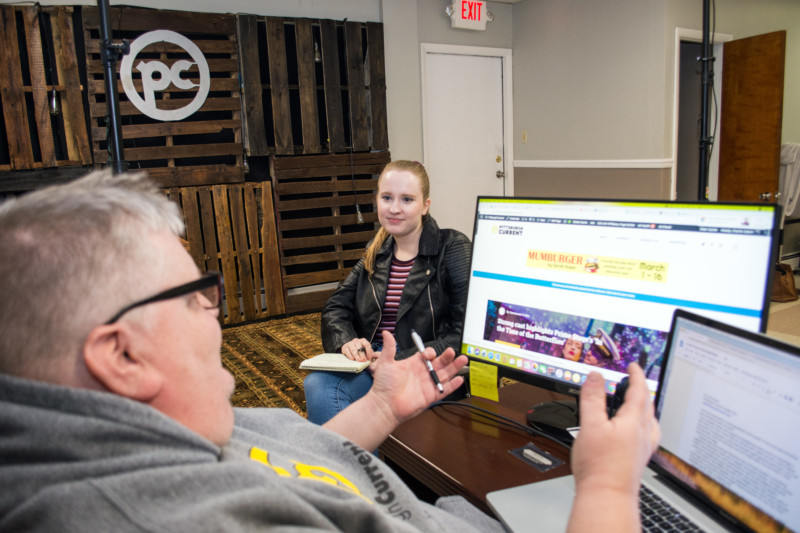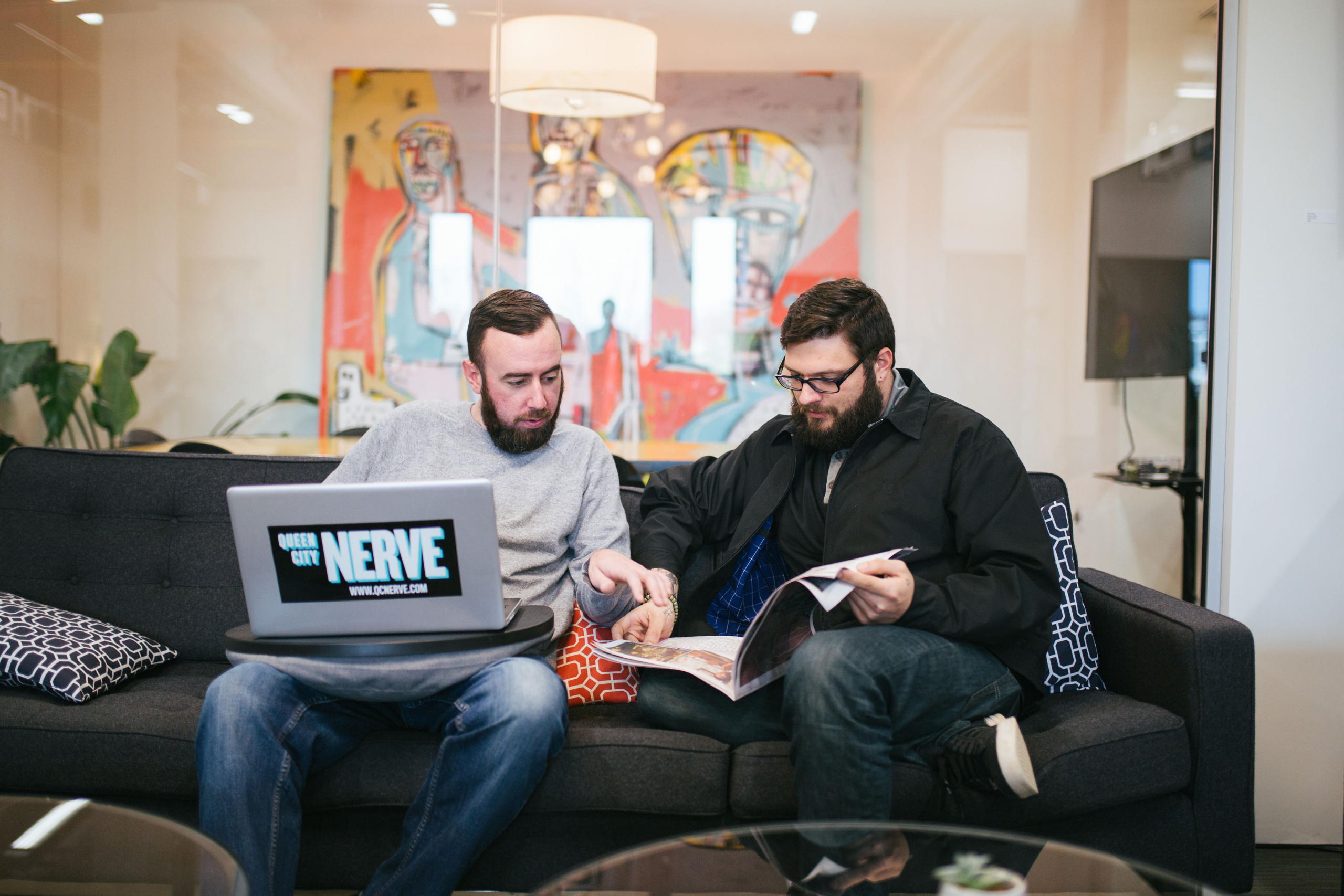Sign up for The Media Today, CJR’s daily newsletter.
Just 35 days after the publisher of Creative Loafing Charlotte laid off the alt-weekly’s seven full-time employees, former editor-in-chief Ryan Pitkin and former account manager Justin LaFrancois distributed 15,000 copies of the first issue of Queen City Nerve. “Print’s not dead,” the cover proclaimed, from the abandoned Creative Loafing racks.
In Los Angeles, former LA Weekly staffers held an open-casket funeral for the alt-weekly after new ownership fired its editors. The #BoycottLAWeekly campaign emerged as former staffers and freelancers resolved to kill a paper they thought had lost its way. An editorial collective of six, most of whom had been on the LA Weekly staff at some point, launched theLAnd, a quarterly magazine, whose first issue arrived last month.
Charlie Deitch believed Pittsburgh’s City Paper had also lost its way. As editor-in-chief of the weekly, he admits he was often insubordinate: “I was mad at them for not for being the publication that I thought they should be.” Deitch’s frequent disagreements with the publisher led to his firing in May 2018. By June, he and City Paper’s former marketing director, Bethany Ruhe, had raised almost $12,000 to start Pittsburgh Current, which now has 10 full-time employees.
ICYMI: A class-action suit has journalists “freaking out”
Baltimore’s City Paper went under in November 2017. Editor-in-chief Brandon Soderberg teamed up with Lisa Snowden-McCray to run Baltimore Beat, but after just four months in print, their publisher pulled the plug. The paper’s announcement on social media read, in part, “Advertising support hasn’t been sufficient to sustain us.” Now, after taking ownership, the pair have relaunched as a nonprofit. Since the publication is run by journalists, they figured, it would be cleaner to drop the for-profit element.
These editors and their partners have gone against prevailing wisdom and built alt-inspired publications from scratch. Though none are published weekly, all the efforts prioritize advocacy reporting, a hyperlocal focus, and coverage of communities and topics not traditionally covered by other established news outlets. As successors to the alt-weeklies that preceded them, they steward a tradition struggling to remain viable.
After the Charlotte Creative Loafing staff was laid off, they went to a local bar to commiserate. Pitkin’s phone buzzed constantly as he received condolence tweets and Venmo donations to pay the tab. The messages sounded the staggering depth of the loss. “We got put into a perfect storm of empathy,” Pitkin says. “That gave us the perfect launching pad.”
The closure of print outlets has left many communities in a local news drought, even in cities as large as Los Angeles. Jennifer Swann, co-editor-in-chief of theLAnd, says that LA Weekly’s closure gave her collective the impetus to launch the magazine. The #BoycottLAWeekly campaign, to kill a once-beloved paper, seemed counterintuitive, but the magazine would give new life to “everything we loved best about LA Weekly” and amplify local longform stories unlikely to appear in other outlets.

Pittsburgh Current Editor/Publisher Charlie Deitch discusses the upcoming issue with Staff Writer Haley Frederick (Photo: Jake Mysliwczyk, Pittsburgh Current Visuals Editor)
In Pittsburgh, Deitch believes the swell of support and outrage from readers speaks to an enduring frustration that goes beyond any single event. “People want a news source that they trust,” Deitch says. “I think some people gave because they were just pissed off at what happened to me. But I think the funding came because they supported the project we wanted to start.”
Baltimore Beat’s nonprofit model banks on reader support, via Patreon subscriptions, and additional revenue comes from the Baltimore Institute for Nonprofit Journalism, which Soderberg helped found in 2017. “The money we receive from our donors is direct feedback from our readers that tells us how much we are needed,” Soderberg says. “By not being for-profit, the metrics for success are just ‘Did we do good work and are people donating money to us because we do good work?’”
The swell of outrage and sympathy may make a perfect launching pad, but a publication’s sustainability depends on converting that wave into sustained readership and cold, hard cash. When I ask the cofounders of Queen City Nerve what allowed them to get off the ground, LaFrancois mentions the public support. Pitkin cuts in: “Also, financial investors.”
ICYMI: Newspaper upgrades CEO’s housing stipend to $35K a month amid buyouts
Before the first issue, Pitkin and LaFrancois expected to fund Queen City Nerve with their savings. An investor ultimately reached out to help but, two months after launching, and provided an initial investment to cover the startup’s first year of operating costs, which they did not disclose. They currently rely on advertising revenue, and continue to distribute the Queen City Nerve to 500 sites around town themselves. Each biweekly run of 15,000 copies costs $1,600 to print, and contributors are paid a modest fee, typically less than $100 per article. “We believe that print ads work, and we need to hammer that home to people,” Pitkin says. “But we’re not going to act as if digital is just a stupid trend.”
Pittsburgh Current has a similar business model. After raising $22,000 on Kickstarter and contributing about $10,000 of their own money, the cofounders partnered with an investor and also participated in a microlending program. The monthly paper also relies on advertisers who, Deitch says, “know what we stand for and how we operate.”
After the first incarnation of Baltimore Beat went under last year, Soderberg and Snowden-McCray did a lot of reflection. “I don’t think ad revenue is the way forward anymore,” Snowden-McCray says. Their decision to operate as a nonprofit meant dropping the print component, a measure both co-founders hope is temporary.
The editors behind theLAnd were determined to release a print product. As a quarterly magazine, however, their mission is not to be a regular source of news. “We wanted something that had a lasting feel,” Swann says, a testament to a moment in the city’s history, full of beautiful longform stories and distributed for free. What the journalists didn’t anticipate was the extent of the cost and work. The first issue of the magazine—born of fundraising, ad sales, and a grant—weighed in at around 130 pages. To help ensure financial sustainability, they are now registering as a nonprofit.
The Nerve’s Pitkin exhibits a cynical idealism characteristic to journalists when he says, “I’m not a greedy businessperson. I’m here to do journalism.” In this print-media climate, you could be forgiven for wondering if he’s naïve. But he and LaFrancois explain their ambition modestly, resolving to keep costs low and remain adaptable. “This can be done on a profitable scale where everyone makes a nice living,” Pitkin says, “and that’s not crazy.”
None of these journalists knew exactly what they were doing when they decided to launch a publication. The process of learning how to operate a business has led them down different paths, each an experiment whose success is not guaranteed. “No one is coming to save us, we have to save ourselves,” Snowden-McCray says. “Nobody has the answers right now, which is terrifying and liberating at the same time.”
ICYMI: Why the left can’t stand The New York Times
Correction: This piece previously stated that Queen City Nerve had “blown through” the initial investment. “Blown through” referred to a smaller portion of fundraising.
Has America ever needed a media defender more than now? Help us by joining CJR today.



